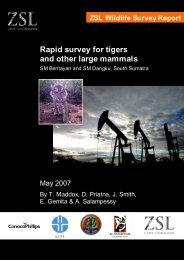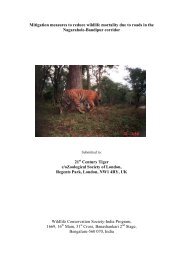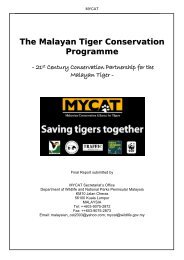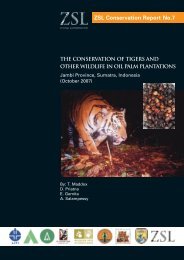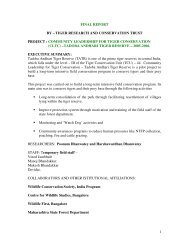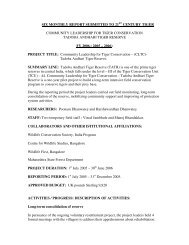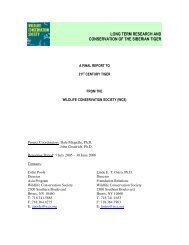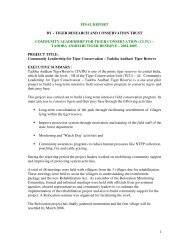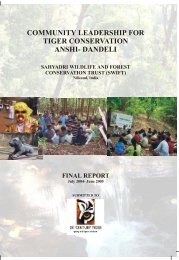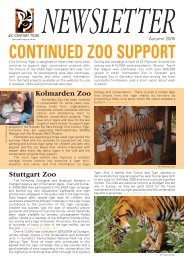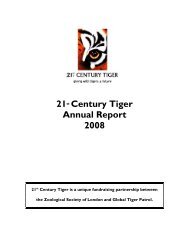Interim Report WCS-Indonesia 06-07 - 21st Century Tiger
Interim Report WCS-Indonesia 06-07 - 21st Century Tiger
Interim Report WCS-Indonesia 06-07 - 21st Century Tiger
Create successful ePaper yourself
Turn your PDF publications into a flip-book with our unique Google optimized e-Paper software.
<strong>Report</strong> prepared by: Noviar Andayani, <strong>Indonesia</strong> Program Director, and<br />
Nick Brickle, Field Conservationist.<br />
Grant Amount $48,727 ($2,927 June 20<strong>06</strong> + $45,800 December 20<strong>06</strong>)<br />
Project Period July 20<strong>06</strong> – December 20<strong>07</strong><br />
<strong>Report</strong>ing Period July 20<strong>06</strong> – June 20<strong>07</strong><br />
Contacts<br />
Colin Poole<br />
Director<br />
Asia Program<br />
Wildlife Conservation Society<br />
2300 Southern Boulevard<br />
Bronx, NY 10460<br />
T: 718.220.5885<br />
F: 718.364.4275<br />
E: cpoole@wcs.org<br />
Carolyn Gray<br />
Director<br />
Foundation Relations<br />
Wildlife Conservation Society<br />
2300 Southern Boulevard<br />
Bronx, NY 10460<br />
T: 718.741.1650<br />
F: 718.364.7963<br />
E: cgray@wcs.org
Summary<br />
This report details activities in the period July 20<strong>06</strong> through June 20<strong>07</strong>. We give details of progress<br />
towards each objective and its outputs. The project activities have concentrated on identification of<br />
potential tiger habitat in southern Sumatra, technical meetings to develop common methodologies,<br />
field surveys using the agreed methodology, and public awareness initiatives.<br />
Progress by June 20<strong>07</strong><br />
The project has seven major objectives: A narrative summary of progress against each is given<br />
below:<br />
Objective 1: To assist the <strong>Indonesia</strong>n Department of Forestry develop a collaborative group of<br />
stakeholders committed to the conservation of Sumatra’s large mammals.<br />
Although tiger conservation activities have been going on in many sites in Sumatra for years, they<br />
have not been well coordinated. After several informal discussions with PHKA (<strong>Indonesia</strong>’s CITES<br />
Management Authority) and other stakeholders, we identified three immediate priorities for<br />
Sumatran tiger conservation:<br />
First, there has never been a systematic and comprehensive field assessment of the status of large<br />
mammal species found on the island, so there is no baseline against which to evaluate the<br />
interventions of Government, NGOs, and donors. Such an evaluation is needed by the Department<br />
of Forestry of <strong>Indonesia</strong> to meet its obligations under the international conventions for biodiversity<br />
conservation. To conduct a systematic assessment as ambitious as an island-wide survey, the<br />
Department of Forestry will require that all stakeholders agree and support the methodology and<br />
that the adopted methodology is capable of providing the basis for a long-term monitoring program.<br />
To address this requirement, <strong>WCS</strong> conducted a technical workshop to develop a common survey<br />
methodology in Bogor on October 9 – 10, 20<strong>06</strong>. The workshop was attended by 24 participants<br />
from 11 major organizations working in tiger conservation. Following the workshop, several informal<br />
coordination and technical meetings were held by <strong>WCS</strong> and collaborating partners. In addition,<br />
technical communications through e-mail have also been maintained among collaborating partners.<br />
Notes of the Bogor meeting are included as Appendix 1.<br />
Second, the existing Sumatran tiger strategic plan is already more than 13 years old. However, it is<br />
still quoted by many organizations for various conservation purposes as it remains the only plan<br />
available. The existing document, however, is increasingly out-of-date and may no longer be<br />
appropriate in all current situations and thus needs to be revisited and updated. Several informal<br />
discussions with PHKA has indicated that updating the strategic plan has become the central issue<br />
for PHKA as the management authority.<br />
Third, there is a strong indication of increased tiger-human conflicts in Sumatra. Several records of<br />
tiger-human conflicts have been reported in Gunung Leuser NP, Tesso Nilo NP, and Bukit Barisan<br />
Selatan NP, while special attention must also be given to the West Sumatra region where conflicts<br />
have been frequently reported over the past three years. Such conflict can become a major threat<br />
to the continued existence of Sumatran tigers locally, as it typically leads to the death or<br />
inappropriate relocation of the tigers concerned. There is therefore a need to formulate a<br />
2
comprehensive and effective mitigation protocol that is applicable to both local and regional levels,<br />
and is understood and followed by management authorities. To address these problems, <strong>WCS</strong><br />
initiated a technical meeting regarding the Sumatran tiger strategic plan and tiger-human conflict<br />
mitigation in Bogor on June 13, 20<strong>07</strong>. The meeting was attended by 13 participants representing<br />
seven major institutions working on Sumatran tigers. This meeting led to a second round of<br />
technical meetings hosted by PHKA in Jakarta on June 28, 20<strong>07</strong>. One of the important conclusions<br />
of this meeting was to hold two rounds of focus group discussions, and a strategic planning<br />
workshop from August 27-31, 20<strong>07</strong>. This will, for the first time in more than ten years, bring all tiger<br />
conservation stakeholders to the same table and allow the Department of Forestry to present in the<br />
clearest terms its needs for the long-term conservation of Sumatran tigers, and vice versa. Such a<br />
process highlights the important role of <strong>WCS</strong> in conserving tigers and large mammals at the<br />
national level. Meeting notes are included as Appendix 2.<br />
Objective 2: By the use of the collaborative group, to assist the Department of Forestry to<br />
assimilate current knowledge about rapid status and threat assessment methods<br />
for tiger. To develop a pilot methodology for the rapid assessment of tigers.<br />
From the technical meeting held October 9 – 10, 20<strong>06</strong> in Bogor, a common rapid methodology was<br />
agreed to by the major stakeholders working on tigers in Sumatra. Such a method is now being<br />
used by all participants, with some additional variations aimed at meeting specific objectives of each<br />
organization involved in the survey. The beauty of this initiative is that each organization uses its<br />
own resources in surveying its ‘own’ sites using the standardized methodology, and shares the<br />
results with the group. By doing this, the pooled data can be analyzed together for the creation of<br />
the first ever Sumatran large mammal atlas. In summary, the workshop led to four main<br />
agreements: 1) a common rapid methodology to assess tiger and large mammal population status,<br />
2) collaborative work on a time-series Sumatra-island wide survey led by PHKA, 3) a common<br />
survey protocol adapted from the <strong>WCS</strong> <strong>Tiger</strong>s Forever initiative, and 4) a centralized database of<br />
Sumatra tiger and other large mammals held by PHKA. To maintain consistency in sampling design<br />
and data collecting, a draft of survey protocol has been developed by <strong>WCS</strong>. Such a protocol is<br />
highly compatible with the <strong>WCS</strong> <strong>Tiger</strong>s Forever protocol and will be kept updated and revised as<br />
more experience is gathered by partners from its first implementation in the field. The latest draft of<br />
the protocol is included as Appendix 3.<br />
Objective 3: To undertake a literature and remote-sensing based selection of potential survey<br />
sites for an initial pilot survey in southern Sumatra.<br />
Because conservation resources for large mammals are focused on relatively few, geographically<br />
limited studies, most of them being national parks, we can answer in great detail about the numbers<br />
of species or individuals in certain areas, but can say little with confidence about their status<br />
nationally or even regionally. The solution to this problem requires a large-scale response,<br />
abandoning preconceptions on where wildlife should be and conducting a rapid sweep survey of a<br />
large area irrespective of habitat type to build an atlas of wildlife survival.<br />
A rigorous remote-sensing analysis has been conducted by <strong>WCS</strong> in order to identify potential tiger<br />
habitats across Sumatra. The <strong>WCS</strong> landscape lab has generated a map of forests and<br />
3
deforestation across the main island of Sumatra. We acquired Landsat-5 Thematic Mapper (TM)<br />
for 1990, and Landsat-7 Enhanced Thematic Mapper (ETM+) for 2000. For scenes with cloud cover<br />
greater than 25% we analyzed additional cloud-free Landsat sub-scenes. Images collected in 1990<br />
and 2000 were co-registered to NASA’s Geocover, a set of ortho-rectified images from the 1990s<br />
(Tucker et al. 2004). The Geocover ortho-rectification process uses Global Positioning System<br />
(GPS) data and accounts for elevation to produce an image set with a root mean square error<br />
(RMSE) of
We expect to complete our survey in BBRS within the next three months, and to start a survey in<br />
BBSNP afterward. In collaboration with the Leuser International Foundation, another extensive<br />
survey is also underway in Gunung Leuser NP, implementing the same protocol.<br />
<strong>Tiger</strong> signs in Bukit Balai Rejang Selatan forest complex, survey grids. Grids highlighted in light blue<br />
are surveyed grids.<br />
To further test the survey methodology, <strong>WCS</strong> in collaboration with ZSL have selected several areas<br />
as the pilot study sites, including Bukit Dua Belas National Park, Riau, Bukit Raja Mandara/Gumai<br />
Pasemah/Bukit Balal (TCU 157), Bukit Barisan Selatan/Semidang Bukit Kabu/Bukit Hitam/Bukit<br />
Dingin/Gunung Dempo/Gunung Patah/Bepagut/Muara Duakisim (TCU 158), Dangku (TCU 154)<br />
and Way Waya. To carry out the surveys, a sub-grant agreement has been signed between <strong>WCS</strong><br />
as the grantor and ZSL as the grantee. This agreement aimed to conduct a rapid survey in Bukit<br />
Dua Belas NP. Such an agreement mandates ZSL to conduct surveys of wildlife occupancy across<br />
six survey cells (17x17km) using the agreed methodology, and to analyze the results and report<br />
estimated occupancy values for key species, relative abundance and distribution. The survey itself<br />
is still underway. An interim report will be delivered by ZSL in August 20<strong>07</strong>.<br />
Objective 5. To use the field surveys as a vehicle to spread awareness about tiger conservation,<br />
including conflict mitigation and law enforcement.<br />
A mobile unit named CIMO (Conservation Information Mobile) has been launched on May 31, 20<strong>07</strong>,<br />
at the <strong>Indonesia</strong>n Department of Forestry headquarters in Jakarta. Beginning from Tanjung Karang,<br />
the capital city of Lampung province, this mobile unit has now started its journey for an awareness<br />
campaign to all main cities in Sumatra. The ultimate target of this mission is to collect a million<br />
5
signatures from local communities and the general public in order to deliver a ‘green message’ for<br />
conserving Sumatran forests and biodiversity. At the local level, the unit will also conduct on-the-<br />
ground conservation awareness road shows along the journey, such as conservation exhibitions,<br />
puppet shows, video shows, leaflets and disbursement of other campaign materials. Some photos<br />
of the CIMO in action are included as Appendix 6. In addition, accompanying the survey and to<br />
spread out the importance of conserving tigers and their habitats in the BBS/BBRS region, <strong>WCS</strong><br />
continues to publish its activity in local and national newspapers. An example is included as<br />
Appendix 7. In this case expert opinion was requested by a local newspaper regarding a case of<br />
illegal possession of tiger parts.<br />
Objective 6. To analyse and present the results of the southern Sumatra rapid assessment<br />
together with recommendations for priority interventions and follow-up action.<br />
Work is still underway and this objective will be accomplished by the completion of the field survey<br />
in all survey sites. A summary of some preliminary results is presented in the following table.<br />
GRID ID TOTAL KM FOOTPRINT OCCASIONS OTHER SIGNS<br />
S25E05 13 P 1 SCT, SCM<br />
S26E05 20 A 0 SCM<br />
S27E05 30 P 1<br />
S29E09 18 P 2 SCT<br />
S30E08 10 P 1 SCT<br />
S29E08 21 P 1 SCT<br />
S30E09 11 P 1 SCT, SCM<br />
S28E08 27 A 0 SCT<br />
S28E<strong>06</strong> 4 P 1<br />
S27E<strong>06</strong> 31 P 2<br />
Note: P = presence; A = absence; SCT = scats; SCM = scrapemarks<br />
Objective 7. To use the results from the initial surveys to develop a statistically robust plan for a<br />
repeatable island-wide assessment of large mammal status and to develop a strategy<br />
for the implementation of that island-wide survey, led by the Department of Forestry<br />
and conducted by Department of Forestry staff and non-government stakeholders.<br />
An agreed common methodology resulting from the technical workshop in Bogor is being<br />
implemented by collaborating partners, including WWF in Tesso Nilo forest complex, Riau,<br />
FFI/DICE in Kerinci Seblat NP, ZSL in Jambi, <strong>WCS</strong> in BBSNP and BBRS forest complex, and <strong>WCS</strong><br />
and LIF in Gunung Leuser NP. The efforts among sites will be comparable and repeatable. In the<br />
surveys, collaborating partners have involved staff of the regional Department of Forestry agencies,<br />
including BKSDA, and national parks. As enough data is collected, a technical meeting will be<br />
conducted to undertake preliminary analyses and to evaluate the effectiveness of the method. Work<br />
is still underway, and we expect to conduct such a technical meeting within the next two months.<br />
This initiative has been highly considered by PHKA as one of the most important issues in the<br />
upcoming strategic plan workshop.<br />
6
General conclusions<br />
1. Based on the field findings of the survey, we believe that the BBRS complex serves as potential<br />
habitat for Sumatran tigers.<br />
2. Upon the completion of this rapid survey, we recommend conducting camera-trapping to get a<br />
better understanding of tiger numbers in the region. Its close proximity to the BBSNP allows a<br />
good chance to create corridors between these regions.<br />
3. We feel the project period reported here has been highly successful in many regards, but<br />
challenges remain. We hope our period of reflection has strengthened our strategy for the<br />
implementation of this project. We are optimistic and excited about the future.<br />
7




